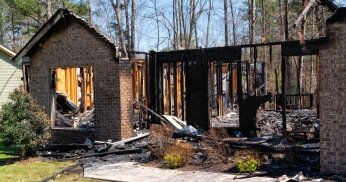 Home Insurance
Home InsuranceWill a GoFundMe gift affect your home insurance claim payout?
This article has been updated from a previous version. When families face unexpected tragedies, crowdfundi...

Compare and find the lowest home insurance rates, save an average of 32%.*
Get 50+ quotes in 3 minutes.
Compare rates from Canada's leading home insurance providers

Home insurance is a complex product, which is why so many people go online looking for home insurance calculators. Instead of using just any home insurance calculator in Nova Scotia, Canada to calculate your premiums, we suggest completing a quote using our online tool. By using LowestRates.ca’s Nova Scotia home insurance calculator, your annual insurance bill could be reduced by hundreds of dollars.
Home insurance isn’t regulated the same way as car insurance. This means there are no mandatory coverages you need to purchase. Home insurance itself isn’t even a requirement by law, though you’ll be hard pressed to find a lender who’ll give you a mortgage without it. This is to say that your home insurance coverage needs? won’t differ substantially from one province to another and your premiums will be based primarily on what type of policy you choose to buy.
But, if you take into account the different conditions within each individual province, you may see an impact on your home insurance rates. That’s why we’re here. Our no-obligation calculator — also known as our quoter — compares the Nova Scotia home insurance market for you so all you have to do is choose the best rate from insurance providers serving your area. Lastly, unlike other online calculators, you can secure your best rate with a real broker or agent and start saving right away.
Looking for more info about your home insurance quotes? Check out our Home Insurance Buying Guide or the Help Centre.
So, now you know just any old online calculator probably won’t give you an accurate estimate, but our quoting tool will. On LowestRates.ca, you can factor in all the things that will impact your home insurance rates, including the value of your home, its contents and where your property is located. Furthermore, there are many risks specific to Nova Scotia that you may want to cover by purchasing “add-ons” or endorsements on top of your base policy. Our quoting tool considers all of it before delivering you the best home insurance rates in Nova Scotia.
A calculator may provide a rough estimator your home insurance costs in Nova Scotia, but it probably won’t be as accurate as one that takes into account all these details. And, it certainly won’t provide the option to secure the rate you receive with a real broker or agent.
All you have to do to get started is enter your postal code and click the “Get Started” button. Once that’s done, you’ll be asked to enter a bit of information about your home. Most of the information required will be inputted automatically as soon as you enter your address. Then, get ready to choose from multiple quotes from home insurance brokers and agents serving Nova Scotia.
Finding an accurate homeowners insurance calculator for Nova Scotia online can be a challenge because there are so many variables to consider. Your monthly payments will be based on how much insurance you purchase, the total value of your home and a number of other factors.
How much home insurance you purchase: Because home insurance isn’t subject to much regulation, how much you pay will be primarily based on how much insurance you purchase and which insurance company you purchase it from. For instance, a basic policy will cost much less than a comprehensive policy. Additional endorsements, such as earthquake insurance or coverage for high-value items, will also bump up costs. Each home insurance company underwrites risk differently, which causes variation in price.
The cost of rebuilding your home: Homeowners insure their properties primarily for the rare instance where they need to repair or replace their homes. The replacement cost of your home will factor into how much your monthly payments will be. However, with the costs of home upkeep? going up across Canada , many homeowners choose to add a guaranteed replacement cost to their policy, which will bump up their insurance premiums.
How much your valuables are worth: In addition to covering the structure of your property, home insurance also covers the contents of your home. There’s often a limit on how much insurance you can purchase for valuables, such as jewelry or art.
In addition, the items below may also influence the cost of home insurance.
Mortgage lender: Depending on the lender you choose, your mortgage lender might require you to buy additional home insurance coverage. This may mean higher premiums. Comparing rates on LowestRates.ca is a great way to ensure you’re not blindsided by extra costs.
Additional fees: Paying your insurance bill late will lead to additional fees. Remember to make sure all your payment methods are up to date.
Once you’re through with our calculator, your home insurance premiums in Nova Scotia can be calculated down to the dollar.
By now, you know that there are a number of factors that influence your home insurance rates, which is why calculating your potential savings can be tricky. We’ve listed some common ones below, but there are even more things that come into play.
There are several factors that can go into calculating your home insurance premiums. This is why comparing the market is the key to saving money on your policy.
Our property insurance calculator for Nova Scotia will evaluate all these factors — and more — to figure out how much money you may be able to save on your home insurance payments.
As soon as you’re done inputting information, you’ll be shown the most competitive rates from home insurance providers serving Nova Scotia. Before we get there though, let’s go over some of the factors that your provider will take into account when calculating your rate.
Location: You’re here to figure out what your home insurance might be in Nova Scotia. While your rates won’t differ greatly because of where you live, specific factors about Nova Scotia might impact how your insurance company evaluates your risk. For instance, living close to the coast might increase your risk of coastal flooding, which may force you to purchase an additional endorsement to cover this risk. To help you navigate these discrepancies, our home insurance calculator for Nova Scotia residents will show you rates from lenders serving your area.
Fire hydrant/station proximity: Your proximity to a fire hydrant or fire station will also impact how an insurance company views you. The closer you live to a fire hydrant or station, the more lower the risk of substantial property damage in the event of a fire. If you live in a rural area far away from the nearest fire station, this may result in higher home insurance premiums.
The age and condition of your home: One of the many reasons a home sustains damage is because of its age and condition. Some examples of things that can cause issues are old, leaky pipes or an old roof that may deteriorate. An older home might result in higher home insurance premiums. Renovating your home to avoid these issues could help you reduce your home insurance premiums and save on your payments. One way to avoid these issues is to buy a newer home with newer finishings.
Whether you work from home or rent out your home: The way you use your home can also have an impact on how risky your home insurance company thinks you are. If you run a business out of your home or rent out an empty room, your home insurance premiums may be higher, and basic coverage may not be sufficient. This is because your home insurance policy might not be enough to cover items or equipment related to the business. You may want to talk to your insurance agent about whether you require an additional commercial insurance policy to cover these things.
How many claims you’ve made in the past: Making multiple home insurance claims is another way to increase your premiums. The more claims you make, the higher risk your insurance company thinks you are. Furthermore, as soon as you make your first home insurance claim, many providers will remove a “claims-free discount,” which will immediately cause your premiums to go up.
Your age: As you get older, it may become more difficult to maintain your home. If this results in accidents inside or on the property, your home insurance premiums may increase.
Your home’s heating system: Generally, a home with an oil heating system has a higher risk profile than those with a gas furnace or electric heating system. This is due to the change of a leaky oil tank with the former. Furthermore, other elements such as a wood stove could increase the risk of a fire or carbon monoxide poisoning. As a result, if your home has either of these, you may need to pay higher premiums.
Other things that can influence your home insurance rates might include:
Because home insurance is loosely regulated and isn’t a requirement, your home insurance coverage won’t differ greatly from one province to another. What might increase or decrease your premiums is whether you choose to purchase additional endorsements based on the characteristics of where you live. For instance, a home in Nova Scotia may be more susceptible to coastal flooding, and residents may choose to purchase an additional endorsement to cover this risk.
The replacement value of your home may also factor into the price of your home insurance premiums, as the primary purpose of home insurance is to replace or repair your home in the event of damage. This is why areas with higher home values are indirectly susceptible to higher home insurance premiums as well.
The type of policy you choose will factor greatly into the cost of your homeowners insurance in Nova Scotia. Our calculator lets you select what type of policy you want when entering your information into the form. This way, we can give you a more accurate estimate for your Nova Scotia homeowners insurance premiums. There are typically four different kinds of home insurance policies:
Comprehensive
A comprehensive insurance policy is exactly what it sounds like — this type of policy covers all perils except those which your insurance company specifically excludes. This policy type, also known as a “special” or “all perils” policy, will give you the most coverage. If your policy names overland flooding and earthquakes as exclusions, for example, you won’t be covered for these things. Depending on which insurance company you go with, your excluded risks may vary. Choosing this type of policy may mean higher monthly home insurance costs in Nova Scotia. Our calculator will give you an exact estimate.
Basic coverage/named perils
A basic or named perils policy will offer less coverage than the comprehensive option. Unlike the comprehensive policy, it will only offer coverage for perils you’ve specifically named in your policy.
Broad coverage
This policy can be described as a happy medium between a comprehensive policy and a basic or named perils policy. A broad policy will include all perils except those that are specifically excluded for the structure of the phone. But it will only cover perils that are specifically named for the contents of the home.
No frills coverage
If you’re insuring a normal home with no serious structural issues, this isn’t the policy for you. A no-frills policy is intended for homes that don’t meet your insurance company’s standards. Homes that have structural damage and other types of issues can be insured with this type of policy until they’re repaired and can qualify for other types of policies.
There are a number of ways to purchase home insurance in Nova Scotia such as an insurance broker, an insurance agent or company, or by going online. One option is to compare homeowners insurance rates in Nova Scotia with the calculator provided by LowestRates.ca. This tool is also known as a “quoter” because it will provide the best home insurance quotes from real Nova Scotia home insurance providers. After inputting some information about your home, the quoter provides a number of competitive rates from the top home insurance providers in the area. If you select one, a broker or agent will be in touch to secure this rate for you.
One of the primary things you can do to save money on your home insurance premiums is to reduce the risk of damage to your home. Here are some options for doing just that:
Install security and safety measures to prevent fire damage and theft: Having a security or fire alarm system can reduce your risk of theft and of fire, which can in turn reduce your premiums.
Install preventative measures against water damage: Having a backflow valve, or a sump pump installed in your home can reduce your premiums.
Use weather-resistant materials to build your roof: Upgrading your roof is another way to prevent weather-related damage and reduce your home insurance premiums. Be sure to use class four asphalt shingles or slate tiles to help your roof withstand intense Canadian weather.
Bundle your home and auto insurance policies: One of the most common ways to get a discount on your home insurance premiums is to bundle your home and auto insurance policies. We also inform car insurance shoppers of this loophole and encourage them to contact their insurance providers to find out how much they can save.
Increase your deductible: A higher deductible means you will have to pay more when you make a claim and the insurance company won’t have to pay as much. However, your premiums will be lower.
Don’t switch insurance companies before the end of your term: While this won’t increase your insurance premiums, you may be forced to pay fees for breaking your policy.
Ask about discounts: This is another great way to save money on your home insurance premiums. There may be discounts specific to your insurance provider that you might not know about. Be sure to ask your broker or agent if there are any additional discounts you might qualify for.
Don’t become a high-risk customer: Having multiple claims, not paying your premiums on time, or owning a vacant property are just some of the reasons why an insurer may consider you to be a high-risk customer.
LowestRates.ca can compare renters and condo insurance. If you’re in the market for either of these policies, just indicate whether you’re looking for renters or condo insurance. Our quoting tool will take your selection into account and will pull your rates accordingly.
If you’re looking for more information about either of these products, feel free to visit either our dedicated condo insurance or renters insurance pages.
An insurance premium, also known as a rate, is the amount you pay for an insurance policy. This can be paid on a monthly or annual basis. When you fill out a form to compare Nova Scotia house insurance rates with our calculator tool, this is what you’ll be shown.
Premium payments can be made on a number of different schedules, depending on your provider. You can pay annually, biweekly or even monthly. Our Nova Scotia home insurance calculator will show you your monthly payments as well as your annual costs. Regardless, a broker or agent will be in touch with you shortly after you complete the form to secure your rate. They’d be happy to answer any questions you have about payment frequency.
An actual cash values policy means the claims payment is based on the current value of the product in a similar condition that needs to be replaced. For instance, if a 10-year-old dryer is damaged, the payment is based on the current value and not the cost of buying a new dryer. Premiums for this type of policy are lower than a replacement cost value policy.
A replacement cost value policy means that the claims payment is based on the value of replacing the product with a brand new one that’s a similar make or model. Premiums for this type of policy are higher than an actual cash values policy.
Endorsements are additional types of coverage (such as sewer backup endorsement) that can be added to your insurance policy.
This is the amount you have to pay towards damages before the insurer will pay. If, for example, there’s $5,000 in damage to your home and you have a $500 deductible, you will pay the first $500 in damage before the insurance company pays the rest. A higher deductible will lead to lower premiums.
Depreciation refers to the decline in value of an item over time.
Perils are unexpected or accidental events.

Jessica Vomiero
About the Author
Jessica is the former Associate Editor for LowestRates.ca. Before joining the team, Jessica worked as a National Online Journalist with Globalnews.ca and previously spearheaded the launch of the Business Section at one of Canada's largest technology websites, MobileSyrup.
 Home Insurance
Home InsuranceThis article has been updated from a previous version. When families face unexpected tragedies, crowdfundi...
 Renting
RentingTenant insurance is an essential safeguard for renters in case of disaster. In addition to priceless peace of mind, it p...
*Shoppers in Canada who obtained a home insurance quote on LowestRates.ca from January to December 2023 saved an average of 32% The average savings percentage represents the difference between the shoppers’ average lowest quoted premium and the average of the second and third lowest quoted premiums generated by LowestRates.ca. Excludes condo and tenant insurance.